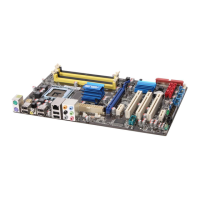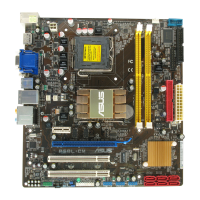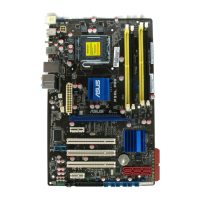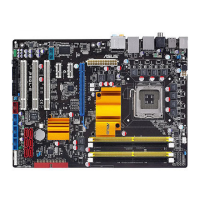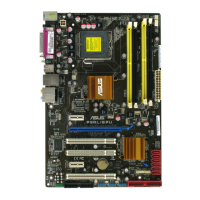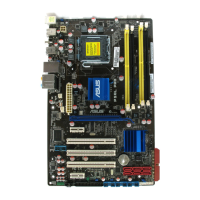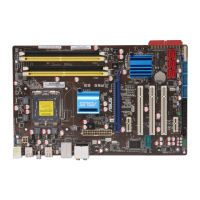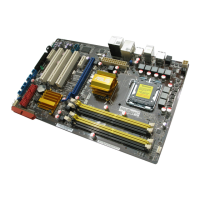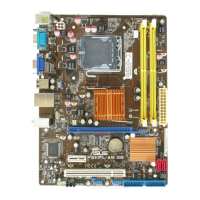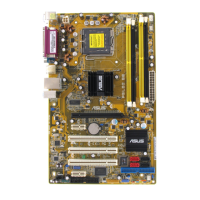Do you have a question about the Asus P5QL SE and is the answer not in the manual?
Contains copyright notice and warranty disclaimers for the manual and product.
Statements regarding FCC compliance and Canadian radio noise emissions regulations.
Symbol indicating proper disposal of electronic equipment.
Essential safety precautions for handling and installing the motherboard.
Explains the manual's purpose, organization, and content structure.
Details where to find more information and explains document conventions and typography.
Details supported CPUs and DDR2 memory architecture, speed, and capacity.
Lists available expansion slots and storage interface support.
Covers LAN, Audio, USB, BIOS features, and manageability options.
Lists included accessories and the motherboard's physical form factor.
Welcomes the user and lists items included in the motherboard package.
Introduces features like Green ASUS compliance and CPU support.
Details the Intel P43 chipset, PCIe 2.0, and SATA 3Gb/s technologies.
Describes ASUS-specific features like EZ DIY and MyLogo2.
Explains CPR feature and crucial safety steps before installation.
Describes the function and location of the motherboard's standby power LED.
Guides on correctly orienting and mounting the motherboard in the chassis.
Illustrates the physical layout of motherboard components and connectors with numbering.
Advises on handling the CPU socket and protective cap during installation.
Step-by-step guide to preparing the CPU socket for installation.
Details positioning the CPU, applying thermal paste, and securing the mechanism.
Instructions for mounting the heatsink/fan and connecting the CPU fan cable.
Introduces the two DDR2 DIMM sockets and their channel assignments.
Guidelines for memory installation and list of approved DDR2-1066MHz modules.
Lists approved memory modules for DDR2-800MHz capability.
Lists approved memory modules for DDR2-800MHz and DDR2-667MHz capability.
Lists approved memory modules for DDR2-667MHz capability.
Detailed steps for inserting and removing DIMM modules into sockets.
Step-by-step process for installing an expansion card into a slot.
Guides on configuring cards and types of PCI/PCIe slots.
Details the function of jumpers on the motherboard.
Explains the purpose and operation of the CLRTC jumper for clearing CMOS.
Identifies and describes the function of ports on the motherboard's rear panel.
Explains LAN port status lights and audio port usage.
Identifies USB 2.0 ports and the serial port.
Describes internal connectors for FDD and S/PDIF modules.
Explains the IDE connector, its jumper settings, and the CD audio connector.
Details Serial ATA connectors and the CPU fan connector.
Covers USB 2.0 headers and the front panel audio connector.
Describes the system speaker connector and ATX power supply connectors.
Explains the system panel connector for power LEDs, HDD activity, and buttons.
Guidance on OS installation and information about the support DVD contents.
Introduces utilities for managing and updating the motherboard's BIOS.
Explains the ASUS Update utility for BIOS management within Windows.
Guides on updating BIOS using ASUS Update via internet or from a file.
Provides steps to create a bootable floppy disk for DOS or startup.
Details the ASUS EZ Flash 2 utility for BIOS updates.
Explains how to use EZ Flash 2 for BIOS updates via floppy or USB.
Details EZ Flash 2 update process and critical precautions.
Details the AFUDOS utility for BIOS updates.
Instructs on backing up the current BIOS using the AFUDOS utility.
Guides on updating BIOS using AFUDOS in DOS mode.
Steps to restore BIOS from a floppy disk using CrashFree BIOS 3.
Steps to restore BIOS from the Support DVD using CrashFree BIOS 3.
Steps to restore BIOS from a USB flash disk using CrashFree BIOS 3.
Explains how to enter the BIOS setup program during system startup.
Describes the menu-driven interface and navigation keys in BIOS setup.
Details the layout of the BIOS setup screen, including menu items and fields.
Explains the menu bar structure and navigation keys used in BIOS setup.
Describes pop-up windows, scroll bars, and general help functions in BIOS setup.
Introduces the Main menu screen and how to navigate its items.
Covers setting system time, date, and floppy drive type.
Explains how BIOS automatically detects SATA devices.
Details configuration options for SATA devices like LBA Mode and DMA.
Introduces the Advanced menu for configuring CPU and system devices.
Details the JumperFree configuration settings.
Explains AI Overclocking settings like Manual, Auto, and Overclock Profile.
Details how to adjust CPU frequency and FSB synchronization.
Covers PCI Express frequency, SB, Vcore, and FSB termination voltage adjustments.
Explains how to set CPU Vcore voltage and GTL reference.
Details DRAM frequency and memory voltage settings for overclocking.
Covers Ratio CMOS Setting and C1E Support configuration.
Details CPUID limit, Virtualization Technology, and Thermal Monitor.
Explains XD feature and Intel SpeedStep Technology.
Configures North Bridge features, graphics adapter, and South Bridge audio/panel.
Manages onboard LAN, JMB368 controller, serial, and parallel port configurations.
Covers Parallel Port Mode and IRQ settings.
Details USB configuration options.
Options to enable/disable USB functions and the USB 2.0 controller.
Configures Plug and Play OS support and device settings.
Configures suspend modes (S1, S3) and ACPI 2.0/APIC support.
Details power loss restoration and wake-up event settings.
Covers resuming from PCI/PCIe devices, RTC alarms, and hardware monitoring.
Specifies the order in which devices are checked for booting.
Options for Quick Boot, Full Screen Logo, ROM display, NumLock, and error handling.
Instructions for setting, changing, and clearing supervisor and user passwords.
Defines access restrictions for BIOS setup items.
Configures when BIOS checks for user passwords.
Details the Tools menu.
Provides access to the ASUS EZ Flash 2 utility for BIOS updates.
Options to exit, save changes, discard changes, or load default settings.
Contains copyright notice and warranty disclaimers for the manual and product.
Statements regarding FCC compliance and Canadian radio noise emissions regulations.
Symbol indicating proper disposal of electronic equipment.
Essential safety precautions for handling and installing the motherboard.
Explains the manual's purpose, organization, and content structure.
Details where to find more information and explains document conventions and typography.
Details supported CPUs and DDR2 memory architecture, speed, and capacity.
Lists available expansion slots and storage interface support.
Covers LAN, Audio, USB, BIOS features, and manageability options.
Lists included accessories and the motherboard's physical form factor.
Welcomes the user and lists items included in the motherboard package.
Introduces features like Green ASUS compliance and CPU support.
Details the Intel P43 chipset, PCIe 2.0, and SATA 3Gb/s technologies.
Describes ASUS-specific features like EZ DIY and MyLogo2.
Explains CPR feature and crucial safety steps before installation.
Describes the function and location of the motherboard's standby power LED.
Guides on correctly orienting and mounting the motherboard in the chassis.
Illustrates the physical layout of motherboard components and connectors with numbering.
Advises on handling the CPU socket and protective cap during installation.
Step-by-step guide to preparing the CPU socket for installation.
Details positioning the CPU, applying thermal paste, and securing the mechanism.
Instructions for mounting the heatsink/fan and connecting the CPU fan cable.
Introduces the two DDR2 DIMM sockets and their channel assignments.
Guidelines for memory installation and list of approved DDR2-1066MHz modules.
Lists approved memory modules for DDR2-800MHz capability.
Lists approved memory modules for DDR2-800MHz and DDR2-667MHz capability.
Lists approved memory modules for DDR2-667MHz capability.
Detailed steps for inserting and removing DIMM modules into sockets.
Step-by-step process for installing an expansion card into a slot.
Guides on configuring cards and types of PCI/PCIe slots.
Details the function of jumpers on the motherboard.
Explains the purpose and operation of the CLRTC jumper for clearing CMOS.
Identifies and describes the function of ports on the motherboard's rear panel.
Explains LAN port status lights and audio port usage.
Identifies USB 2.0 ports and the serial port.
Describes internal connectors for FDD and S/PDIF modules.
Explains the IDE connector, its jumper settings, and the CD audio connector.
Details Serial ATA connectors and the CPU fan connector.
Covers USB 2.0 headers and the front panel audio connector.
Describes the system speaker connector and ATX power supply connectors.
Explains the system panel connector for power LEDs, HDD activity, and buttons.
Guidance on OS installation and information about the support DVD contents.
Introduces utilities for managing and updating the motherboard's BIOS.
Explains the ASUS Update utility for BIOS management within Windows.
Guides on updating BIOS using ASUS Update via internet or from a file.
Provides steps to create a bootable floppy disk for DOS or startup.
Details the ASUS EZ Flash 2 utility for BIOS updates.
Explains how to use EZ Flash 2 for BIOS updates via floppy or USB.
Details EZ Flash 2 update process and critical precautions.
Details the AFUDOS utility for BIOS updates.
Instructs on backing up the current BIOS using the AFUDOS utility.
Guides on updating BIOS using AFUDOS in DOS mode.
Steps to restore BIOS from a floppy disk using CrashFree BIOS 3.
Steps to restore BIOS from the Support DVD using CrashFree BIOS 3.
Steps to restore BIOS from a USB flash disk using CrashFree BIOS 3.
Explains how to enter the BIOS setup program during system startup.
Describes the menu-driven interface and navigation keys in BIOS setup.
Details the layout of the BIOS setup screen, including menu items and fields.
Explains the menu bar structure and navigation keys used in BIOS setup.
Describes pop-up windows, scroll bars, and general help functions in BIOS setup.
Introduces the Main menu screen and how to navigate its items.
Covers setting system time, date, and floppy drive type.
Explains how BIOS automatically detects SATA devices.
Details configuration options for SATA devices like LBA Mode and DMA.
Introduces the Advanced menu for configuring CPU and system devices.
Details the JumperFree configuration settings.
Explains AI Overclocking settings like Manual, Auto, and Overclock Profile.
Details how to adjust CPU frequency and FSB synchronization.
Covers PCI Express frequency, SB, Vcore, and FSB termination voltage adjustments.
Explains how to set CPU Vcore voltage and GTL reference.
Details DRAM frequency and memory voltage settings for overclocking.
Covers Ratio CMOS Setting and C1E Support configuration.
Details CPUID limit, Virtualization Technology, and Thermal Monitor.
Explains XD feature and Intel SpeedStep Technology.
Configures North Bridge features, graphics adapter, and South Bridge audio/panel.
Manages onboard LAN, JMB368 controller, serial, and parallel port configurations.
Covers Parallel Port Mode and IRQ settings.
Details USB configuration options.
Options to enable/disable USB functions and the USB 2.0 controller.
Configures Plug and Play OS support and device settings.
Configures suspend modes (S1, S3) and ACPI 2.0/APIC support.
Details power loss restoration and wake-up event settings.
Covers resuming from PCI/PCIe devices, RTC alarms, and hardware monitoring.
Specifies the order in which devices are checked for booting.
Options for Quick Boot, Full Screen Logo, ROM display, NumLock, and error handling.
Instructions for setting, changing, and clearing supervisor and user passwords.
Defines access restrictions for BIOS setup items.
Configures when BIOS checks for user passwords.
Details the Tools menu.
Provides access to the ASUS EZ Flash 2 utility for BIOS updates.
Options to exit, save changes, discard changes, or load default settings.
| Brand | Asus |
|---|---|
| Model | P5QL SE |
| Category | Motherboard |
| Language | English |
